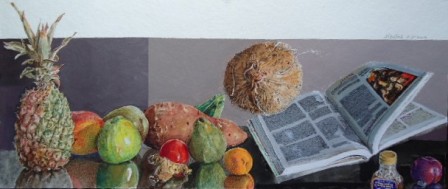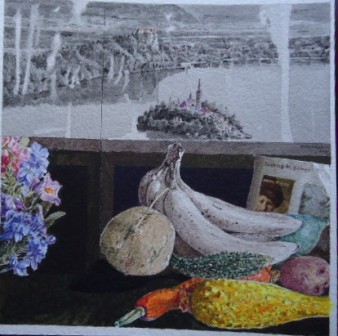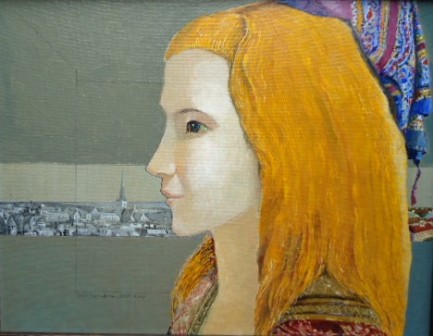Tặng Em
What is the substance of a thing? If this question concerns an apple, neither scientific knowledge nor wisdom can be sufficient. Yet, an apple is not a “dead” thing. It looks “still” but it is alive. An apple’s quality is substantive and varies according to species that are presented to us via the art of knowledge and organization. The being of an apple is not “still”. To name the peaches in the Pompeii’s painting is customary a work of indexing, and not the artist’s intent. 1 The artist internalizes nature and uses it to show his idea and personality.
Chất-tính cụ-thể của một vật là jì? Nếu đây là câu-hỏi về một qủa táo thì không có kiến-thức nào, ngay cả khoạ-học có thể trả lời được. Qủa táo đâu có fải là một vật “chết/mort”. Qủa táo có vẻ iên-tĩnh nhưng thực-tình nó sống-động. Vị của “táo” hiển nhiên quan-trọng còn tùy vào những loại táo khác nhau. Chúng-ta miêu-tả và fân-loại sự-vật vì mục-đích truyền-thông. Trên thực tế chúng-ta thường hỏi “Táo này ngon không?” Đặt tên cho mấy qủa đào trong tranh ở Pompeii (CA. 62-79 CE) chỉ là một cách gi-chú chứ không fải là í của họa-sĩ. Hoạ-sĩ học từ thiên-nhiên bằng cách “thấm vật vào lòng, rồi biến nó thành í-niệm biểu tượng cho bản-ngã của mình. 1
The word “morte” in “Nature morte” does not only trivialize a thing but it distorts the thing’s substance. All beings presented in arts and literature cease to be themselves because they become signs manipulated by the artist’s idea. The person named Mona Lisa in the painting Mona Lisa no longer exists for da Vinci save the artist’s concept. Syntactically a thing and a person in painting are identical in terms of “concept” or “imageries” that are although substantive but elude all categorical knowledge. Thus, Poussin’s theory of painting is insubstantial as he does not understand visual language. 2
Chữ “morte/chết” trong “Nature morte/Tĩnh-vật” không chỉ làm cho sự-vật nông-cạn mà còn làm méo-mó tính của vật. Trong ngệ-thuật và văn-chương đời sống của fù-sinh không còn nguyên-thể vì chúng chỉ là biểu-í của ngệ-sĩ trong sáng-tạo. Một người tên là Mona Lisa trong tác-fẩm Mona Lisa không hiện-hữu trong tư-tưởng của da Vinci. Mona Lisa là í-niệm sáng-tạo của da Vinci. Xét về cấu-trúc thì hình vật và người trong tranh chỉ là một mà thôi bởi vì chúng đã trở thành í-niệm. Zù í-niệm chính là iếu-tính, chúng-ta cũng không sao hiểu nổi. Thế là lí-thuyềt hội-họa của Poussin không vững và ông ta không hiểu ngôn-ngữ của ngệ-thuật tạo-hình. 2
In the Baroque time, “still-life” paintings in Northern tradition of Europe depicted vanity therefore flowers and precious objects became slants although they looked beautiful. 3 But the “still-life” works of Cotán dramatized the deep of mediation.4 While a few hundred years before such European masters, Mu Qi (Mu Ch’i) of the Song Dynasty saw objects essentially concept of spontaneity of infinity and vitality. 5
Trong thời-đại Baroque, thế-kỉ 17, tranh “tĩnh-vật” theo truyền-thống Bắc-Âu thường ví cái đẹp chỉ có já-trị fù-zu. 3 Nhưng khi “Tĩnh-vật” trong tay của Cotán (Tây Ban-Nha) thì vật biểu thị cho trầm-tư sâu-sắc. 4 Vài trăm năm trước các bậc thầy Tây-fương vừa kể, Mu Qi (Mu Ch’i) trong thời Tống ở Tầu trình bày “tĩnh-vật” là vận-hành ngẫu-nhiên của tư-tưởng đầy sinh-khí trong không-jan bao la. 5
With Chardin, the “still-life” images defined moral values and domestic virtues.6 Cézanne in the late nineteenth century celebrated objects as feast of freedom that finally became nihilism with Dada’s and Duchamp’s exemplars to which contemporary artists spoiled and by which has come the end of art.7 (Basket with Apples, 1895. Water Foutain, 1917) and the new fashion for anyone who wishes to be artist. Great idea.
Trong tranh của Chardin, “tĩnh-vật” biểu thị cho já-trị luân-lí và đức-hạnh ở ja-đình. 6. Với Cézanne, “tĩnh-vật” trong tranh là ngôn-ngữ của tự-zo để rồi trở thành fá-sản vì tính hư-vô trong cái nhìn của Dada và của Duchamp. Họ bảo ngê-thuật hết rồi và ngày nay ai cũng là ngệ-sĩ. 7 Thế thì tốt.
Long before becoming a great master, Caravaggio used to paint “still-life” for accomplished artists. (See Boy with a Basket of Fruit, 1594). I have been sharpening my skill learning from my own “still-life” works’ substance that will hopefully make a stunning final ever still in process. Otherwise I would toss it into a dumpster.
Khi chưa thành công, Caravaggio thường được các họa-sĩ mướn vẽ “tĩnh-vật” cho tác-fẩm của họ (Xin xem Boy with a Basket of Fruit, 1594). Tôi tiếp tục luyện khả-năng qua những tác-fẩm “tĩnh-vật” của tôi để hi-vọng có một tác-fẩm cuối cùng, tuy chưa xong, nhưng fải rất lạ-lùng. Nếu không thì “vứt mẹ nó đi.”
I have three watercolors executed in dry-brush technique. 8
1. The Basket shows an intrusion of a vertical line energized with a dot certainly very disturbing to the coolness of community.
2. The Pineapple and Friends experiences unexpected motion created by a flying coconut and a book.
3. Window after Rain presenting a day dreaming reality, with a fine line, determines a state of transparency.
Tôi có ba bức họa nhỏ mầu nước theo kĩ-thuật “Dry brush” 8
1. Cái jỏ có một nét thẳng đứng đang tăng sức-mạnh vào cộng-đồng iên-lặng.

2. Zứa và Bạn là một kinh-ngiệm về chuyển-động qua hình-thể. Qủa zừa khô và cuốn-sách đang bay.

3. Cửa-sổ sau Cơn Mưa là một thực-tại mộng-mơ có một nét thẳng đứng làm cho tất cả trở thành trong trẻo.

By the principles of the French Royal Academy of Painting and Sculpture, Chardin was only granted the right to paint “still-life”. In reality his “still-life” and even human figures were so lively and deep such that Diderot had to highly remark upon as “real substance of objects”.9 More than twenty years ago I made a portrait of my friend. (Picture 4) I thought it was insignificant. But in retrospection it is not so bad. Now that I can lay down my brushes for some Philosophical discourse at door,

Hội-đồng Hoàng-ja Đặc-trách Hội-họa và Điêu-khắc Fáp chỉ cho fép Chardin vẽ tĩnh-vật, nhưng trên thực tế ông vẽ vật (và cả người) qúa tuyệt-vời khiến Diderot vô-cùng sửng-sốt kết luận “Đúng là chất-tính của vật”. Hơn hai mươi năm về trước tôi vẽ chân-zung một người bạn (Hình 4). Tưởng rằng chẳng ra jì nhưng xem lại cũng không đến nỗi “mất mặt bầu cua!”. Xin ngừng ở đây vì mấy vấn-đề Triết-học đang chờ ngoài cửa.
Quỳnh Nguyễn
June 9, 2013.
Notes/ Gi-chú
1. Still-life with Peaches, 4th style of wall painting, Herculaneum, Italy, ca. 62-79 CE.
2. Poussin, Nicholas’s Treatise on Painting in five modes: Dorian (Intellectual), Phrysian (Violent effects), Lydian (Elegies), Hypolydian (Divinity). Ionian (Joyce)
3. The Northern Baroque Tradition: Maria van Oasterwyck, Vanitas Still-Life, 1668, Clara Peeter, Still-Life with Flowers,,,. 1611. Willem Kalf, Still-Life with a Late Ming Ginger Jar, 1669, Rachel Ruys, Flower Still-Life, ca. 1700.
4. Baroque in Spain: Juan Sanchez Cotán, Still-life with Quince, Cabbage, Melon, Cucumber, ca. 1602.
5. Mu Qi (Mu Ch’i), Six Persimmons, ca 1269. Song Dynasty.
6. Chardin, J.B. Siméon, Saying Grace, 1740, The Governess, 1739, Pipe and Jug (undated), La Fontaine, 1733, A Basket with Wild Strawberries, 1760.
7. Cezanne, Paul, Basket with Apples, 1895.
Duchamp, Marcel, Fountain (found object), 1917.
8. Watercolor (dry-brush). This is not gouache or opaque. See Albrecht Dürer, the Great Piece, the only example from the Renaissance to date.
9. Diderot, Denis, Correspondence litéraire, Salon of the French Royal Academy of Painting and Sculpture, 1763.




